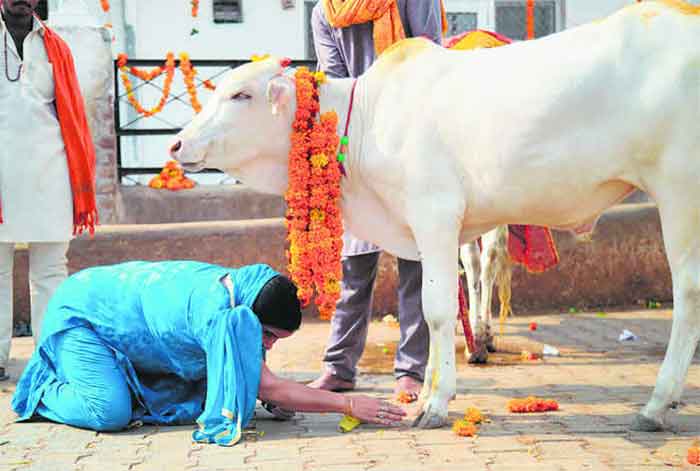
There was no idea of gomata or gau mata in ancient India. Evidence of beef eating is found even in the oldest Indian religious text of supposedly divine origin, Rigveda. Professor D N Jha has given ample proof of the killing of cows in his famous book, The Myth of Holy Cow (2002). He cited several Western scholars and Indian Indologists such as H H Wilson, the first person of the Chair of Sanskrit at Oxford in 1832, Rajendra Lal Mitra, a product of the Bengal Renaissance, Mahamahopadhyaya P V Kane, a conservative Marathi Brahmin and the only Sanskritist for being honoured with the title of Bharat Ratna for his gigantic work History of Dharmasastras, H D Sankalia, the father of post-Independence Indian archaeology, Laxman Shastri Joshi to give concrete shreds of evidence to the practice of killing of cattle and eating their flesh prevalent in ancient India.
Professor Jha observed, “the Sangh Parivar has never turned its guns towards them but against historians who mostly relied on the researches of the above-mentioned distinguished scholars”. There are detailed descriptions of animal sacrifices and many references to the ritual of cattle slaughter in Vedic texts. Interestingly, the cattle were killed not only for sacrifice but also for food. “Sacrifice and sustenance went hand in hand in the predominantly pastoral society of the Vedic Aryans”. Interested scholars can find pieces of evidence from such texts as Taittiriya Brahmana, Taittiriya Samhita, Gopatha Brahmana of the Atharvaveda.
The practice of killing cattle, including the cow, is also substantially attested by archaeological material. For instance, Professor Jha refers to H D Sankalia and claims that throughout the Pleistocene period ranging from about a hundred thousand to ten thousand years, bones of the cow/ ox have been discovered more frequently and at a large number of places in the riverbeds and other deposits than of any other animal. Despite the massive evidence of cattle-killing and beef eating in the Vedic period, many Hindutva scholars have argued that the “cow was scared and unslayable”. Their scholarship rests only on the occurrence of the word agenda (not to be slain) for the cow in the Vedic texts. But the term, Jha claims, has been used at four places in the Rigveda and the Atharvaveda as a masculine noun equivalent to bull or ox and 42 times with a feminine ending to mean a cow.
In the sixth century BC, Buddhism and Jainism posed a severe challenge to the practice of cattle slaughter. For they staunchly accepted non-violence or ahimsa as a way of life. But that did not lead to the withdrawal of cattle flesh or other types of meat from the Indian dietary menu. Gautam Buddha himself is known to have eaten beef and pork. There is ample evidence that flesh meat was not unpopular in Buddhist kitchens. In the case of Jainism, their philosophy is “impartial in its respect for all forms of life without according to any special status to the cow”. Buddhism and Jainism, though, contributed to the emergence of ahimsa teaching; neither “seems to have developed the notion that the cow was sacred and unslayable”.
The practice of ritual and haphazard killing of animals, including cattle, continued even in the post-Mauryan periods. Even Manu, whose law code (200 BC-AD 200) belongs to the early centuries before and after Christ and is the most representative of the legal texts, “allows the consumption of the flesh, among others, of all domestic animals with teeth in one jaw. He excludes the camel from the list of editable animals but not the cow, nor does he say that this animal is edible. He asserted that the animals were created for the sake of sacrifice, that killing on ritual occasions is non-killing and the injury (himsa) as enjoined by the Veda (vedavihitahimsa) is known to be non-injury”.
The non-vegetarian dietary practices are also standard in the early Indian medical treatises of Charaka, Sushruta and Vagbhatta. The patterns of killing of cattle get reflected in early Indian secular literature. In the Gupta period, Kalidasa hints at the story of Rantideva, who killed many cows daily in the kitchen. In the post-Gupta centuries, many texts refer to cow killing. Bhavabhuti (AD 700) refers to two instances of guest welcoming that included killing a heifer. Rajashekhara (tenth century) refers to killing an or a goat in honour of a guest. And Somadeva (eleventh century) tells the story of seven Brahmin boys who ate a cow. In the twelfth century, Shriharsha refers to various non-vegetarian delicacies served at a gala marriage feast and mentions two fascinating instances of cow killing.
References
D N Jha. Against the Grain: Notes on Identity, Intolerance and History. Manohar, 2018.pp. 35-70.
Abu Siddik teaches at Plassey College, West Bengal, India. He is a bilingual author and has been published in India and abroad. He has three critical books— Representation of the Marginalized in Indian Writings in English (Falakata College Cell, 2015), Misfit Parents in Faulkner’s Select Texts (Authorspress, 2015), Banglar Musolman (Sopan, 2018); two poetry books and a short story, published by Authorspress in 2020 —Rugged Terrain, Whispering Echoes, A Birdwatcher and Other Stories. Website: www.abusiddik.com










































